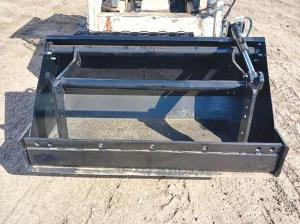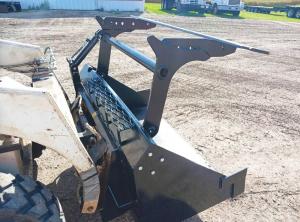2023 - Volume #47, Issue #6, Page #11
[ Sample Stories From This Issue | List of All Stories In This Issue | Print this story
| Read this issue]
“Grapple Blade” Great
For Spreading Gravel, Dirt
 |
 |
“I just raise the blade the desired amount and spread away,” says McLaen. “It works just as well when cleaning barns or working with other loose material.”
McLaen started with a 60-in. bucket he got from a neighbor with whom he often trades metal scrap. It had been modified with 3-pt. hitch brackets and was headed for the scrap pile.
“The paint wasn’t even worn off the cutting edge, though it sat outside for years,” says McLaen.
McLaen cut off the brackets and added the grapple arms. Instead of tines, he fitted the arms with a blade.
“I figured I could use it with gravel and feather the gravel out,” says McLaen.
The main frame of the grapple is 3/4-in. thick steel plate salvaged from old logging equipment a friend gave McLaen. He lengthened the arms to reach the cutting edge, which was mounted to parts of an old plow. A length of 2-in. steel pipe was mounted between the arms to stiffen them. The main frame was welded to a pivot shaft he fabricated from a section of an old Vibra Shank 3/8-in. thick rock shaft.
“I found two pieces of pipe that fit inside the pivot shaft and butt welded them to 5 by 5-in., 1/4-in. steel plate,” says McLaen. “I put grease zerks in the pivot shaft before inserting the mounting pipes and bolting the plates to the top inside rear of the bucket.”
A 1 1/2-in. hydraulic cylinder salvaged from an old Bobcat grapple bucket was put to work on the new grapple. McLaen mounted a clevis point to the top of the bucket. He routed the hydraulic hoses from the cylinder, down the backside of the bucket to the loader arm pivot point. Open-sided brackets spot welded to the loader arm secure the hoses back to the auxiliary valves.
“The hoses slide into the brackets easily,” says McLaen. “The arrangement keeps them from getting out of place and pinching.”
McLaen reports the biggest challenge was positioning the clevis points for the cylinder. “It took a big compass and a bunch of cardboard to figure out how to make the cylinder fit,” he says. “There was only one sweet spot. Everything else was too far or just not right.”
McLaen has a long-standing tradition of using oil well sucker rod on everything he fabricates. “If I have to, I’ll just weld a piece on,” he says. “This time it was easy. The sucker rod was just right for clevis pins to hold the cylinder.”
After using the bucket a few times, McLaen added a safety feature. He installed an expanded metal step to the top of the bucket. It reduces the chances of slipping when entering and exiting the cab.
“The bucket is working great,” says McLaen. “Thanks to my neighbor, I probably have around $275 or less in it. The cutting edge at $68 and the hoses at about $140 were my biggest costs. The rest was mostly salvage.”
Contact: FARM SHOW Followup, Dale McLaen, 13756 Hwy 11, Rutland, N.D. 58067 (ph 701-678-5232).

Click here to download page story appeared in.

Click here to read entire issue
To read the rest of this story, download this issue below or click here to register with your account number.




